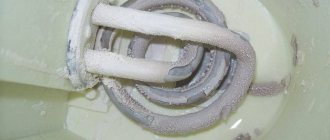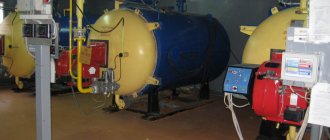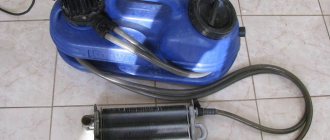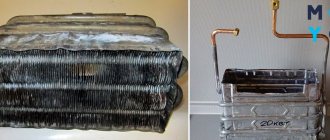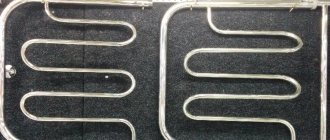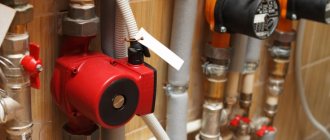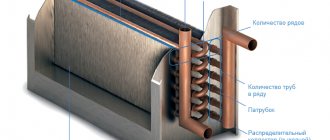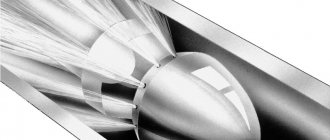The use of even relatively clean water as a heating fluid leads to clogging over time, not to mention untreated, contaminated coolant. The boiler heat exchanger is the first to suffer from clogging and scale. Precipitation on its walls narrows the cross-section of the pipe and the thermal conductivity of the metal, which affects not only the heating system, but also the operation of the boiler, which has to operate at increased power levels.
In the article we will look at how internal and external cleaning of the heat exchanger of a gas boiler is carried out. The process is not particularly difficult and can be done independently, without the involvement of specialists.
Read in the article
When and how often do you need to clean the gas boiler heat exchanger?
Manufacturers of gas boilers recommend cleaning the heat exchanger annually, or at least once every 3-4 years if a relatively clean coolant of low hardness is used, which does not change with each heating season, and a mechanical cleaning filter is installed in the system. It is recommended to carry it out before the start of the heating season.
Heat exchanger of a gas boiler in section. The use of contaminated coolant and lack of regular cleaning led to serious consequences: serious overheating and almost complete clogging.
In the absence of regular maintenance, there are signs of a clogged heat exchanger:
- reduction in heating performance - is expressed in a lower (10-20%) temperature of the heating radiators than before and, accordingly, in the room temperature when the boiler is operating at the same constant power;
- increased gas consumption - noticeable if you analyze the meter readings and the operating mode of the boiler for the last month and a month earlier that was similar in temperature (preferably the same month in the previous heating season);
- increased noise or the appearance of new sounds when water moves through the heat exchanger;
- increased operation of the circulation pump.
If internal cleaning has not been carried out for more than a year, one of the above symptoms is observed - it is recommended to rinse the heat exchanger with special chemical solutions over the next few months, which we will discuss later, and then perform mechanical cleaning. Otherwise, contamination and scale not only cause increased consumption and lower heating output, but can also lead to overheating, burnout of the heat exchanger, and failure due to increased load of the circulation pump.
If the boiler is installed in a system with natural circulation, due to a serious reduction in the cross-section (throughput) of the heat exchanger, there may be difficulties with the movement of coolant through the system.
Cleaning and flushing the plate heat exchanger. Heat exchanger cleaning service.
In the process of work, our company uses special chemistry that does not lead to destruction of the surface of the plates, does not react with seal materials, and at the same time effectively removes almost any type of deposits and scale that form as a result of operation.
The work on chemical washing of plate heat exchangers carried out by our company is characterized by high quality, meeting international standards, reliability, and optimal price-quality ratio.
As part of the service, we clean and rinse the heat exchanger plates with chemicals, including acid.
Where is it located and how to remove it
Basic methods involve completely removing the heat exchanger from the boiler. Cleaning without disassembly and removal is possible only when using the hydrodynamic flushing method, carried out exclusively by specialists. However, the extraction process does not require special skills or special equipment, and the design of all models of gas boilers is not fundamentally different.
The location of the heat exchanger using the example of a wall-mounted Baxi LUNA-3 Comfort 240 Fi.
- The first step is always to remove the front cover; simply unscrew the bolts and carefully remove it.
- We drain the water from the boiler through the appropriate outlet valve (usually located inside the boiler), be sure to release the pressure if there is any.
- Next, you need to remove the front combustion chamber cover. In simple models it is immediately visible; in more complex models, the combustion chamber can be insulated with fire-resistant, heat- or sound-insulating material, or rubber seals. It may also be necessary to remove the top of the combustion chamber.
- Typically, temperature or water flow sensors are installed on the pipes of the heat exchanger, which must be turned off.
- All that remains is to remove the fastening mechanisms, clamps, disconnect the pipes and remove the heat exchanger. Be careful, as when disconnecting the heat exchanger, residual water may flow out of the heat exchanger; cover the electronic components and wiring under the combustion chamber.
In floor-standing gas boilers with an open combustion chamber, the process is even simpler, since the heat exchanger is accessible immediately after removing the housing cover. In general, you can study the structure of your boiler model using the images of the operating instructions; for many models there are visual examples of disassembly analysis on YouTube.
Cleaning the boiler heat exchanger with your own hands - getting started
Before starting work, firstly, you should disconnect the heating boiler itself from the source of electricity.
In order to access the system's heat exchanger, you will need the following tools:
- Phillips screwdriver
- Flat head screwdriver
- Adjustable wrench.
It is possible that in your case, to flush the heat exchanger of a gas boiler, you will not need the entire set of tools from the list above, but we still recommend having each of them “in reserve.”
For example, to access the heat exchanger of a double-circuit turbocharged boiler with a boiler model SuperMaster 24SE manufactured by Hermann, you will need to do the following:
- remove the front cover from it, after which you will have access to the “insides” of the boiler,
- Then remove the cover from the tightly closed combustion chamber, for which you will have to unscrew six bolts.
In turbocharged boilers, as in the case under consideration, the combustion chamber lid must have a rubber seal on all sides. Under the cover there is a combustion chamber of the heating boiler. In order to gain access to it, you must remove at least a few walls coated on the inside with fire-resistant material. To do this, unscrew the next five screws again and open the combustion chamber.
At the bottom of a turbocharged boiler, you will most likely find a pile of debris drawn inside by air. It will be most convenient to remove it using an ordinary household vacuum cleaner.
The lower part of the combustion chamber is occupied by a number of nozzles that pass gas into the system. All nozzles should be thoroughly cleaned - the holes through which gas is supplied should become transparent.
Next, you need to remove the heat exchanger itself. In the model under consideration, there are no threaded connections; the tube through which water is supplied and discharged is connected using an adapter. On one side of the heat exchanger there is a temperature sensor, from which the wires should be carefully disconnected.
Methods for flushing the heat exchanger of a gas boiler
Mechanical (manual) cleaning
The simplest, but also the least effective method, great for minor blockages. External cleaning of the heat exchanger fins is carried out with any convenient tools: a toothbrush and other hard brushes, a spatula, a scraper, a cable. Be careful not to remember or break the plates that are vulnerable to strong mechanical stress.
Rinsing in a container with solution.
After rough external cleaning, the heat exchanger must be placed in a container with a solution of hydrochloric or citric acid (a proportion of 100-200 grams per 10-20 liters of water is sufficient), you can use any descaling agent. The heat exchanger must be left to “acidify” in the solution for 30-40 minutes, after which the remaining scale must be carefully wiped off. Also try, as far as possible, to clean the coil through which the coolant moves from the inside. It is better to use a special steel brush as a cleaning agent.
Dry cleaning
It involves pumping more aggressive chemicals through the heat exchanger using a circulation pump connected to the heat exchanger pipes.
So, how to flush the heat exchanger of a gas boiler:
- Citric Acid – Citric acid washing is the most common DIY method. 2 standard bags of 100 grams per 10-12 liters of water are enough. It is better to use warm water (50-70°C).
- Thermagent Active is a well-known universal and effective liquid for washing heat exchangers of heating equipment from scale, limescale, salt and other deposits. The concentrate is diluted in a ratio of 1 to 9; to increase efficiency, it is better to use water heated to 40-50°C. The average cost is 1,500 rubles per 10 kg canister.
- STEELTEX Cooper is also one of the most effective products, but is recommended only for use for cleaning heat exchangers made of steel, aluminum and other light alloys. The concentrate contains corrosion inhibitor additives. Diluted in proportion with water from 1:6 to 1:10, depending on the degree of contamination. Cost – 1300 rubles for a 5 kg canister.
- Detex concentrate liquid – contains effective biodegradable surfactants, designed for washing steel, cast iron and copper heat exchangers of modern boilers. Diluted to achieve a concentration of 2-5% (200-500 ml per 10 l).
- Hydrochloric acid - effective for severe scale, used in a concentration of 2-5%. It is important not to overdo your concentration.
We recommend using 10 liters of solution, this will be enough for stable pumping through any heat exchanger. A hose connected to the heat exchanger is placed in a container with a solution (canister, durable container, plastic bucket). Next, on the other side of the heat exchanger, a hose is connected to the circulation pump and, finally, a hose goes from the pump to a container with a solution, as low as possible to the bottom or hermetically mounted into the bottom of the container. As a result, the solution circulates between the canister and the heat exchanger.
The duration of pumping is 30-40 minutes, after which the heat exchanger must be thoroughly rinsed several times with ordinary running water.
Hydrodynamic flushing
To carry out cleaning, it is not necessary to disassemble the boiler and remove the heat exchanger. However, only specialists can carry out the process, since special equipment and strict adherence to safety precautions are required.
The principle of hydrodynamic flushing consists of running a special liquid through the system under high pressure using special equipment - a booster. For greater effectiveness, the liquid contains abrasive substances.
Chemical method
This is a set of measures aimed at flushing the heat exchanger using all kinds of chemical reagents that can destroy and rid the system of scale. The choice of reagent is made based on the characteristics and amount of contamination.
The implementation of the method is as follows: using a special device, the reagent is introduced into the heat exchanger, it circulates inside for several minutes, and then is removed from there with rinsing water. Together with the remaining reagent, the PHE must be freed from dissolved scale and contaminated water. If one washing cycle is not enough, the process is restarted, and possibly more than once. In addition, more active reagents are introduced.
The advantage of chemical washing is that the unit does not need to be disassembled, which saves time and money for the event.
In addition to the composition of the cleaning reagent, you should pay attention to the temperature of the washing solution, because it also affects the cleaning efficiency. The heating level of the solution is selected taking into account the type and composition of scale.
An unsuccessful cleaning operation and the aggressive effects of the chemicals used can lead to partial destruction of materials and the formation of cracks in plates and gaskets. And the use of liquid cleaning agents, for example, hydrochloric acid, increases the degree of damage and reduces the life of the heat exchanger. Therefore, chemical washing should be carried out using certified reagents, entrusting the job to real professionals!
Cleaning the secondary DHW heat exchanger in double-circuit boilers
In double-circuit boilers, the process greatly depends on the type of heat exchanger: additional secondary or single bithermic.
In the case of the secondary heat exchanger, everything is simple; it is cleaned in exactly the same way as the primary one.
A bithermic heat exchanger is a single structure consisting of a hot water supply circuit pipe inserted into a heating circuit pipe. It is extremely difficult to clean such an internal structure; washing is carried out either chemically or hydrostatically: by specialists using special chemistry and a booster. Heavily contaminated elements, where the clearance is narrowed by more than 80-90%, must be replaced.
How is heat exchanger flushing performed?
- Connect the pump to a 220 Volt outlet.
- Check how securely the clamp hoses are fastened.
- During the washing process, ensure that the liquid returns to the container.
- After 20 minutes, the hoses are swapped. This will allow the solution to move in the opposite direction.
We carry out the same operation with hot water supply. The structure is connected to the DHW circuit:
- Connect the pump outlet to the cold media supply.
- Lower the entrance into the container.
- Connect a hose to the hot water outlet. The second end is lowered into the cleaning solution.
After cleaning the DHW, the secondary circuit heat exchangers are washed. To ensure fluid movement in both directions, the hoses are swapped. The boiler is completely cleaned. Finally, the pump is flushed by pumping clean water.
Special cleaning equipment
A booster (installation for washing heat exchangers) is a rather rare and expensive equipment (40-90 thousand rubles), which is simply unprofitable to buy for personal purposes, no matter how often you clean it. It is a container with a built-in circulation pump that supports a change in flow direction - reverse, which increases the efficiency of washing. The devices are resistant to any reagents used.
PIPAL PUMP ELIMINATE 20 V4V
One of the best Italian-made units. It has compact dimensions and optimal performance - 2600 l/hour (44 l/min). Tank volume – 18 l, permissible pressure – 1 bar. Known for its simplicity and reliability.
Cost : 38,000 rub.
BWT Cillit SEK 28
An equally well-known, proven German-made installation. Capacity – 2400 l/hour, the operating principle is no different from the previous installation, designed for higher temperatures – up to 60°C. It has even more compact dimensions and a convenient handle for transportation.
Cost : 57,000 rub.
How to choose a water softener for a gas boiler and extend the life of the heat exchanger
Preparing detergent
A remedy that makes flushing heat exchangers more effective can be easily prepared at home. You buy a special substance at a hardware store (can be liquid or in powder form), and then dilute it in water according to the instructions. The resulting solution must be poured into a large container - at least 25 liters.
Next, the pump output is connected to the “return”. The inlet is lowered into a container with the solution, and a hose is connected to the supply. The other end is lowered into a container with the prepared solution.
Cost of professional cleaning
All work is completed within a day. The price of flushing the heat exchanger of a gas boiler depends on the region, the power and model of the boiler unit, the company’s markup, the equipment used and chemicals.
- In Moscow and Moscow Region, the cost of washing is in the range of 3,500-9,000 rubles.
- In St. Petersburg, services cost between 2,900-7,000 rubles.
- In the regions, prices for such services range from 1,800-4,500 rubles.
Hello, friends. How is the heat exchanger of a gas boiler washed with citric acid? Do I need to remove the heat exchanger? What are the stages of this work? The answers to these questions follow.
This article tells how to wash the heat exchanger with a well-known folk remedy - citric acid. What are the advantages of this method? Two cleaning methods are considered.
Definition
A heat exchanger is a mechanism that directs heat from one coolant (water) to a second (air).
It contains special components and cavities.
If it is exposed to hard water for a long time, then scale, rust and other contaminants form in it. They need to be eliminated promptly.
The regularity of cleaning is determined by the quality of the water and the parameters of the boiler itself, as well as the degree of load on it.
Whatever washing method is chosen, first of all, deposits are removed using mixtures of different acids or special reagents. This is followed by rinsing with water.
If you do not carry out these operations, then:
- The heat exchanger will overheat.
- The efficiency of the boiler will decrease.
- The boiler may break down. In an advanced case, an explosion is not ruled out.
Cleaning heat exchangers, washing heat exchangers - choosing a method!
In-place flushing of heat exchangers is selected as the main cleaning method in the following cases:
- when it is necessary to flush the heat exchanger, both brazed and semi-welded;
- when the degree of contamination is assessed as low or medium (acid washing of heat exchangers).
Dismountable cleaning of heat exchangers is the most effective and is used if the degree of contamination of the heat exchangers is assessed as severe. This may be due to the fact that the channels are completely clogged with deposits and the heat exchangers need to be cleaned. In such cases, manufacturers advise resorting to the dismountable method, which is guaranteed to remove any contaminants.
Scheduled preventative maintenance is less painful, significantly extending their life. At the same time, productivity improves. The main signs of the need for maintenance are: an increase in pressure loss, failure to maintain a temperature schedule in relation to the passport values. The conclusion of technical specialists is that the heat exchanger needs to be cleaned.
A timely and regular procedure for washing the heat exchanger plates - removing deposits, scale, dirt, microorganisms of devices of any type significantly extends the service life, which is much cheaper than its overhaul. Nothing is more costly than unplanned production stoppages.
However, these costs can be avoided because much can be planned before the problem becomes a reality. You just need to outline a plan of preventive measures in advance. For example, seals are subject to wear. However, if they are replaced in time, leaks that lead to various costs can be avoided. The plates may become dirty. Scale negatively affects heat transfer and impairs performance. In some cases, increased pressure drop can cause serious problems. Timely cleaning and flushing will help avoid such problems.
Frequency of cleansing
Typically, maintenance periods are reflected in the passport of each model. However, these are indicative values. And they mean that the device will work in comfortable conditions. In practice, the heat exchanger needs to be washed more often.
The need for these operations arises when:
- There is a big difference in the calculated parameters of the unit from the values in its passport. Efficiency decreases and thermal energy consumption increases.
- According to the plan, the rubber seals of the heat exchanger are being changed.
- Very dense deposits appeared on its plates.
About price tags
The price of flushing a gas boiler heat exchanger depends on the method chosen. The cheapest is mechanical. You can do it yourself. But you need to act extremely carefully. A stiff metal brush is used.
The second method is hydrodynamic. It uses jets of powerful pressure water. Special settings apply. They develop line pressure up to 1500 bar.
The effectiveness of the method is very high. But the price tag too -...
The third method is chemical. A booster is used - a special device. With its help, a composition for acid cleansing is introduced. This composition circulates in the heat exchanger for several hours and effectively cleanses it. Even carbonate scale is removed.
Example of a device before and after surgery.
Disadvantages of this method:
- high price tag of the reagent,
- metal wear,
- a lot of toxins are formed.
Citric acid is safer. It removes many deposits along with reagents such as Xanax and Silit. And it costs only...
Do-it-yourself heating flushing
For self-flushing radiators, mechanical cleaning technology is most applicable. In this case, you will not have to use any special equipment or specific chemicals. Before you wash the heat exchanger of a gas boiler with your own hands, you should prepare the necessary materials:
- rags or old thick clothes. With their help, it will be possible to protect the bathtub from damage during the process of flushing the radiators in it;
- fum tape or plumbing linen with a tube of sealing paste;
- a pipe that allows you to connect a hose to threaded connections.
The equipment you will need is the following:
- two hoses;
- a set of keys;
- brush;
- steel wire brush;
- buckets, basin and rags.
The actual cleaning of the heat exchanger and lines consists of several stages.
- A hose of the appropriate diameter is connected to the drain pipe of the heating system. The other end of the hose is discharged into the sewer.
- A second hose is connected to the highest point of the system. As a rule, such a point is either a branch to the expansion tank or a safety group. The tank or safety group is unscrewed and a pipe is screwed into its place, onto which a hose is put. The second end of the hose is connected to the water supply.
- When everything is ready, water is supplied to the system. This makes it possible to get rid of scale and contaminants deposited in the system lines.
- Start draining the coolant. To do this, remove the hose through which tap water was supplied. The connection point to the system is not blocked. Under the influence of gravity, water begins to drain through the drain pipe at the lowest point of the line.
Radiators are removed from the dehydrated system
Care must be taken when doing this. It is likely that the threaded connections on them are coked and you will have to make some efforts, trying not to damage the threads. The removed radiators are transferred to a bathtub, previously covered with rags or thick fabric
Here they are washed with running water, treated with a brush and a steel wire brush. After flushing the radiator, it is carefully inspected again for any remaining contaminants. The radiators are installed in place.
The lines are filled with fresh water through the drain pipe. At the same time, monitor the formation of air pockets in the pipes and radiators. You can get rid of air bubbles by slightly opening the Mayevsky valves on the radiators. As soon as the air stops hissing and water begins to ooze from the tap, close it. As the lines fill, it is advisable to repeat this procedure several times. After the actual washing of the gas boiler heat exchanger is completed with your own hands, the heating system is put into operation. As the coolant begins to circulate, air pockets in the radiators may re-form. To eliminate them, the Mayevsky cranes are manipulated again. Some of the air will be removed independently through the air vent. As the pipelines and radiators are freed from air, the coolant pressure will drop. To level it, it is necessary to additionally pump water from the water supply. In addition, you should check the pressure in the expansion tank.
For an overview of connection diagrams for heating radiators in a private house, see here.
Cleansing. Method 1
Cleaning the heat exchanger of a gas boiler with citric acid is profitable and safer. The first method of this operation involves removing the heat exchanger.
In addition to the acid itself, you will need:
- The valves supplying gas to the heating are blocked.
- The water is drained.
- The heat exchanger is removed. The bolts and water pipes are carefully unscrewed. The overheat indicator is removed from the case.
- A cleaning composition is being prepared. Per liter of water – 20 grams of acid.
- The heat exchanger is placed in the basin. This composition is poured into it. The device is completely immersed in it.
- The composition heats up for 5-10 minutes.
- The composition merges.
- The heat exchanger is thoroughly washed. Running water is used.
- The device is placed in its position. All fasteners and tubes are screwed in. The overheating indicator is strengthened.
Cleansing. Method 2
In this method, you need to use a special washing complex. It includes:
- Tank for cleaning composition.
- Pump.
- Connecting hoses.
- Boiler shutdown.
- Draining.
- Removing the circulation pump. A washing unit is placed in its position. It is connected with special hoses.
- Preparation of the composition in the tank of the designated complex. The proportions are the same as in the first method.
- Turn on the pump. The composition circulates. It is necessary to control the pressure in this complex. It shouldn't go off scale.
- Draining the composition.
- Rinsing the device with water.
- Dismantling of the washing complex.
- Return to the pump location.
If the boiler has two circuits
Washing the heat exchanger of a double-circuit gas boiler with citric acid is carried out using one of these methods:
- Bithermic: the coolant and water for hot water are heated.
- Work with a secondary heater made of stainless steel.
A booster is used for the operation. After all, it is very difficult to remove such a mechanism. Hoses from the tank are installed instead of water outlets.
Then the pump and boiler are turned on. The heating temperature should not exceed 50-55 degrees
Many modern boilers have a secondary heat exchanger, for example “Vailant A, Ferroli Divatech H C24.
Citric acid against scale
Now let's talk about citric acid against scale , how it works and how it works. On warm surfaces, the scale layer behaves much more effectively in terms of burnout; there is no protective relay here. And metals cannot withstand loads. The metal melts, cracks, tears, and this is just from some half a millimeter of scale! In industry, metallurgy and thermal power engineering, such facts are not uncommon. Therefore, descaling is carried out there almost on schedule and equipment downtime is tolerated when the scale layer has reached its limit values. So, if you don’t clean the scale on time, you can get holes in the pipes and boiler explosions in the boiler room. And before that, the efficiency of the device will drop as low as possible.
If the enterprise does not have water treatment, it is necessary to carry out constant descaling and descaling. Limescale also causes a sharp increase in fuel or electricity consumption. After all, in order to heat the entire boiler, for example, and then heat the scale, you will have to spend a lot of energy.
From all of the above, we can conclude that citric acid is not the last solution for scale in any industrial production. Moreover, even a water softening system may be installed at an enterprise, but it may be worn out or outdated and, as a result, work ineffectively. Then citric acid against scale regains its relevance.
In addition, descaling affects any surface. Do you know how to clean scale with citric acid or not? On heating elements this procedure must be carried out especially carefully. It doesn’t matter whether you use anti-scale acid or regular soda, but there will always be marks on the surfaces. Chips, cuts, scratches, cracks... And it is in these small nicks that new scale will accumulate. And much faster than the first time, depositing on perfectly smooth surfaces.
And now it becomes difficult to eliminate such scale and pick them out of all the cracks. But most importantly, such old stuck scale is a place for corrosion to form. That is, you will have to fight not just scale, you will have to solve corrosion issues.
But, alas, citric acid against scale is currently not affordable for everyone, and then today only anti-scale products can be used as protection against scale. Although if you still try and choose even the simplest anti-scale filter, then after using it a little, you will immediately understand what is more profitable for you.
What types of citric acids for scale can be seen in our markets and stores? Here it is immediately worth noting that the options for citric acids against scale can be easily divided into the simplest substances that can be easily obtained and used at home; everyone has them at hand. And the second group is more extensive - citric acids for descaling, which are used specifically for descaling complex industrial equipment.


